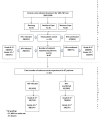Drug-associated adverse events and their relationship with outcomes in patients receiving treatment for extensively drug-resistant tuberculosis in South Africa
- PMID: 23667572
- PMCID: PMC3646906
- DOI: 10.1371/journal.pone.0063057
Drug-associated adverse events and their relationship with outcomes in patients receiving treatment for extensively drug-resistant tuberculosis in South Africa
Erratum in
- PLoS One. 2013;8(5). doi:10.1371/annotation/644591a8-8ae6-450e-974e-1cd1f08f52c7. Groubusch, Martin [corrected to Grobusch, Martin P]
Abstract
Background: Treatment-related outcomes in patients with extensively drug-resistant tuberculosis (XDR-TB) are poor. However, data about the type, frequency and severity of presumed drug-associated adverse events (AEs) and their association with treatment-related outcomes in patients with XDR-TB are scarce.
Methods: Case records of 115 South-African XDR-TB patients were retrospectively reviewed by a trained researcher. AEs were estimated and graded according to severity [grade 0 = none; grade 1-2 = mild to moderate; and grade 3-5 = severe (drug stopped, life-threatening or death)].
Findings: 161 AEs were experienced by 67/115(58%) patients: 23/67(34%) required modification of treatment, the offending drug was discontinued in 19/67(28%), reactions were life-threatening in 2/67(3.0%), and 6/67(9.0%) died. ∼50% of the patients were still on treatment at the time of data capture. Sputum culture-conversion was less likely in those with severe (grade 3-5) vs. grade 0-2 AEs [2/27(7%) vs. 24/88(27%); p = 0.02]. The type, frequency and severity of AEs was similar in HIV-infected and uninfected patients. Capreomycin, which was empirically administered in most cases, was withdrawn in 14/104(14%) patients, implicated in (14/34) 41% of the total drug withdrawals, and was associated with all 6 deaths in the severe AE group (renal failure in five patients and hypokalemia in one patient).
Conclusion: Drug-associated AEs occur commonly with XDR-TB treatment, are often severe, frequently interrupt therapy, and negatively impact on culture conversion outcomes. These preliminary data inform on the need for standardised strategies (including pre-treatment counselling, early detection, monitoring, and follow-up) and less toxic drugs to optimally manage patients with XDR-TB.
Conflict of interest statement
Figures


References
-
- Dheda K, Warren RM, Zumla A, Grobusch MP (2010) Extensively drug-resistant tuberculosis: epidemiology and management challenges. Infect Dis Clin North Am 24: 705–725. - PubMed
-
- Shean KP, Willcox PA, Siwendu SN, Laserson KF, Gross L, et al. (2008) Treatment outcome and follow-up of multidrug-resistant tuberculosis patients, West Coast/Winelands, South Africa, 1992–2002. Int J Tuberc Lung Dis 12: 1182–1189. - PubMed
-
- Dheda K, Shean K, Zumla A, Badri M, Streicher EM, et al. (2010) Early treatment outcomes and HIV status of patients with extensively drug-resistant tuberculosis in South Africa: a retrospective cohort study. Lancet 375: 1798–1807. - PubMed
Publication types
MeSH terms
Substances
LinkOut - more resources
Full Text Sources
Other Literature Sources

